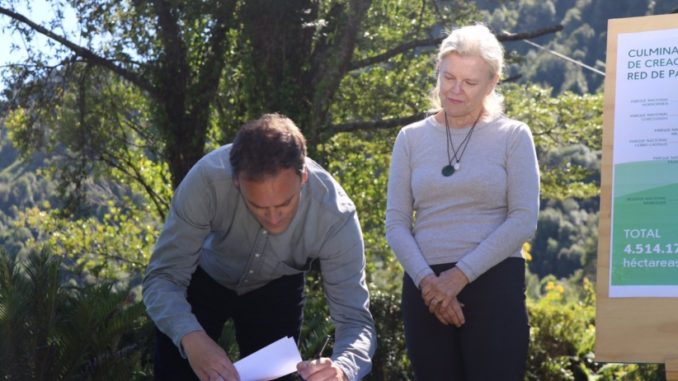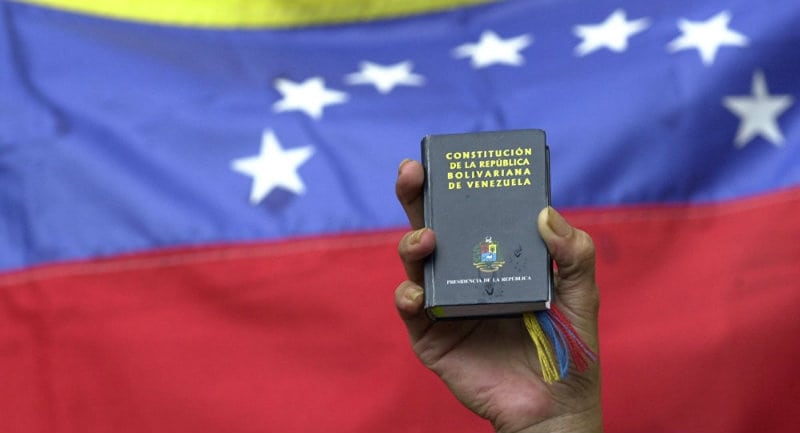
SANTIAGO – Chile’s National Assets Minister Felipe Ward today traveled to the Los Lagos region to celebrate the creation of the Patagonian Parks Network in the company of Kristine Tompkins, president of Tompkins Conservation, after the official procedures for the eight parks that form part of this network were concluded by the office of the Comptroller General of the Republic.
“Following a long process, the creation of the Patagonian Parks Network, set up thanks to the largest private donation in history for conservation purposes, has now been concluded. It is a very important milestone, because national parks are the garden of all Chileans and we must take care of them,” said Minister Felipe Ward during his visit to the Douglas Tompkins Pumalin Park.
En el Parque Pumalín anunciamos este gran hito junto a Kristine Tompkins: se concreta la Red de Parques de la Patagonia, un esfuerzo de años. Además, firmamos un convenio de colaboración con la Fundación Tompkins Conservation. pic.twitter.com/eepQR9jIzP
— Felipe Ward (@Felipeward) February 11, 2019
The Parks Network came into force after the publication in the Official Gazette of the decree that creates the Kawésqar National Park (the largest of the eight parks that make up the Patagonian Parks Network), the last step that was pending in the setting up of this network for the protection of the natural environment. This network was established thanks to a donation of 407,000 hectares by Tompkins Conservation in March 2017, which, added to State contributions, led to the creation of five National Parks (Melimoyu, Patagonia, Kawésqar, Cerro Castillo and Pumalin Douglas Tompkins) and the enlargement of three others (Hornopirén, Corcovado and Isla Magdalena). The network covers an area of 4.5 million hectares.
The minister and Kristine Tompkins also signed an agreement whereby the ministry is committed to supporting the Patagonia Parks Route, a scenic route of 2,800 kilometers that stretches between Puerto Montt and Cape Horn. This route links up 17 National Parks with 60 local communities, thus providing an opportunity for economic development through tourism as a by-product of conservation.
Un lunes realmente provechoso en #ParquePumalín junto a @TompkinsConserv donde nuevamente nos comprometimos en el trabajo colaborativo para cuidar la nueva #RutaDeLosParques. pic.twitter.com/Z3kRCGJNxE
— Bienes Nacionales (@MinisterioBBNN) February 12, 2019
“The Parks Network is the starting point for something even greater, which is the Patagonian Parks Route, which protects more than 11.5 million hectares under the National Park category, and represents a world reference for conservation,” said Kristine Tompkins, President of Tompkins Conservation and UN Environment Patron of Protected Areas.
“Chile is at the forefront of these issues thanks to the work of different stakeholders in the public and private sectors, who have seen conservation not only as an effective tool to preserve ecosystems and counteract climate change, but also as a motor for local economies,” she added.
The agreement commits the National Assets Ministry to support the Parks of Patagonia Route, which provides a scenic route of 2,800 kilometers between Puerto Montt and Cape Horn, and links up 17 National Parks with 60 local communities.
The 17 parks that make up the route are as follows:
- Alerce Andino National Park
- Hornopirén National Park
- Pumalín Douglas Tompkins National Park
- Corcovado National Park
- Melimoyu National Park
- Queulat National Park
- Isla Magdalena National Park
- Laguna San Rafael National Park
- Cerro Castillo National Park
- Patagonia National Park
- Bernardo O´Higgins National Park
- Kawésqar National Park
- Torres del Paine National Park
- Pali-Aike National Park
- Alberto de Agostini National Park
- Yendegaia National Park
- Cape Horn National Park
Chile connects 17 national parks with 2,800 km Patagonia route



